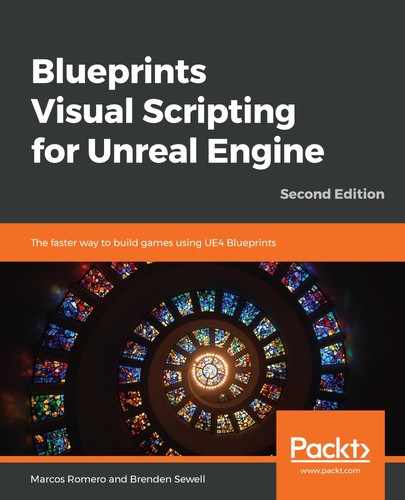After starting up Unreal Engine Editor, a two-tab window will appear. The Projects tab is used to open existing projects and the New Project tab is used to create a new project, as shown in the following screenshot. The New Project tab has templates that can be used for the creation of a project. There are templates made with Blueprint and templates made with the C++ programming language. In this book, we will only use Blueprint templates:

At the bottom of the preceding screenshot, there are three boxes with project configuration options. These options can be modified later in the project, and they are as follows:
- Target hardware: Desktop / Console or mobile/tablet
- Graphical level: Maximum Quality or scalable 3D/2D
- Starter content: With or without Starter Content
The starter content is a content pack with simple meshes, materials, and particle effects. The examples in this book assume that the starter content is being used.
The following are brief descriptions of each template:
- First Person: For games with a first-person perspective
- Flying: Contains a simple spaceship controlled by the player
- Handheld AR: For augmented reality applications
- nDisplay: For multi-display projects such as caves
- Puzzle: For puzzle games using a mouse or touchscreen
- Rolling: Contains a physics-based rolling ball controlled by the player
- Side Scroller: For 3D side-scroller games
- 2D Side Scroller: For side-scroller games with 2D sprites
- Third Person: Contains a playable character with a camera that follows it
- Top Down: Contains a character controlled by a mouse with a camera at a great distance above it
- Twin Stick Shooter: Shows how to map the input to control movement and firing independently
- Vehicle: Contains a simple physics-driven vehicle controlled by the player
- Virtual Reality: Contains essential features for virtual reality games
- Vehicle Advanced: Contains a more complex vehicle with suspension
Select the Third Person template, choose settings, location, and Name of the project, and then click the Create Project button. After the project loads, the main screen of the Unreal Engine Editor will be displayed, as shown in the following screenshot:

The main screen of the previous screenshot is also known as the Level Editor. These are the key panels of the Level Editor:
- Toolbar: Located at the top of the Level Editor. It contains buttons with commonly used operations. You can use it to save the Level, build the lighting, access other panels, and play the Level in the Editor.
- Viewport: Located at the center of the Level Editor. It shows the Level that is being created. You can use the Viewport panel to move around the Level and add objects on the Level.
- Modes: Located to the left of the Level Editor, the Modes panel can be used to change the editing mode of the Level Editor for a specialized interface such as Landscape mode.
- Content Browser: Located at the bottom of the Level Editor. It is used to manage the assets of the project. An asset is a piece of content of an Unreal Engine project. For example, Materials, Static Meshes, and Blueprints are all assets. If you drag an asset from Content Browser and drop it in the Level, the Editor creates a copy of the asset to place in the Level.
- World Outliner: Located to the right of the Level Editor. It lists the objects that are in the Level.
- Details: Located to the right of the Level Editor, below World Outliner. It shows the editable properties of an object that is selected in Viewport.
